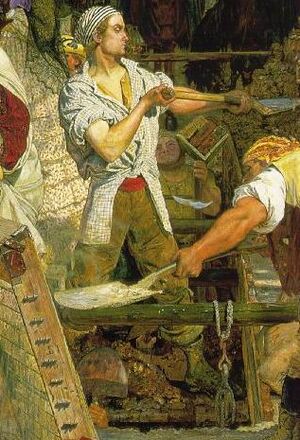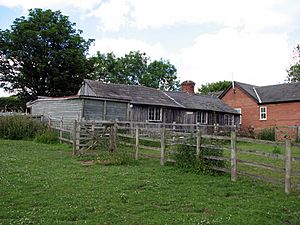Navvy facts for kids

A navvy was a special kind of manual laborer. The word "navvy" comes from "navigator" or "navigational engineer." This term was first used in Great Britain in the late 1700s. At that time, many canals were being built. These canals were sometimes called "navigations." Navvies were the strong workers who built these big civil engineering projects. In North America, the word "navvy" can also mean a large digging machine, like a steam shovel.
Contents
Most navvies in Britain during the 1800s were English. However, many Irish workers also joined them. About 30% of the navvies were Irish.
By 1818, many Irish workers traveled to North America. They were attracted by good wages. They became a big part of the workforce building the Erie Canal in New York State. Navvies also helped build canals in Britain. By the 1900s, they were the main group of workers on these projects.
From Canals to Railways
After canals, railway projects became popular in Britain from 1830 onwards. This time was known as the "railway manias." The same term, "navvy," was used for the workers building rail tracks. They also built tunnels, deep cuts in the ground, and raised embankments for the tracks. At the peak of railway building in Britain, there were 250,000 navvies working.
Navvies on railway projects mostly used hand tools. They also used explosives, especially for digging tunnels or clearing tough spots. Mechanical diggers were available in the 1840s. These machines were first called 'steam navvies.' But they were not used much in Britain or Europe until later. This was because there were many skilled workers who were not expensive. In places like the United States and Canada, where workers were harder to find and more costly, machines were used more often. In the U.S., the word "navvy" even came to mean a steam shovel itself, not a person.
Being a navvy was a unique cultural experience in the 1800s. Local newspapers often wrote about navvies. They sometimes described them as wild men. But these stories often missed that navvies formed families and raised children, even though they had to travel a lot for work.
Navvies working on the Liverpool and Manchester Railway were paid daily. It was said that they spent most of their money on ale (a type of beer). This left little money for food. If workers were too sick to work, money was taken from their wages. Instead, they were given meal tokens. These tokens could be used at food stands for soup and bread. At first, these tokens were thin slips of paper. But these paper tokens could be copied by forgers. So, the Liverpool and Manchester Railway started giving out six-sided brass tokens. These tokens had "LMR" stamped on them and were exchanged for meals. You can see these tokens and learn more about them at the Museum of Science & Industry in Manchester.
In the mid-1800s, some people tried to help navvies with their religious needs. Elizabeth Garnett led efforts to preach to them. They also had a newsletter and did charity work. A big construction boss named Sir Samuel Morton Peto even encouraged religious services for his workers. He also provided some social help for navvy communities.
Living Conditions
Many navvies building railways in England in the early 1800s lived in temporary homes. These were often called "shanty towns." They were not very clean or comfortable. Navvies often worked in rural areas. Also, people sometimes had a negative view of navvies. Because of this, two-thirds of railway construction sites had special housing built for them. At first, these "huts" were built quickly and meant to be temporary. Not much thought was given to comfort or cleanliness. This was a common problem for everyone during the Victorian era. These shanties were unhealthy places to live. It was common for a navvy community to suffer from serious sicknesses.
Navvies often shared housing, and some even slept on floors. Most navvies were English, but about 30% were Irish. Sleeping areas were often separated by nationality. In one case, a fight broke out between English and Irish navvies in a shanty town. Local police arrested 12 people. However, this does not mean all English and Irish navvies always fought.
Over time, living conditions improved. The homes were built with more care. Sometimes, land was even offered so navvies and their families could grow their own food.
Navvies moved around a lot for work. They also faced dangerous work environments. The dangers depended on the land they were working on and how local people treated them.
Safety rules were limited back then. So, navvies were often injured or even died on the job. For every mile of rail built, about 3 workers died. This number was even higher when working on tunnels. Many navvies died while building the Woodhead Tunnel. This led to an investigation in 1846. This investigation eventually led to the need for a special committee to look into railway laborers in 1846.
Sometimes, there was tension between locals and the navvies, who were seen as outsiders. This could lead to violence, like fights or even deaths.
However, as time passed, local businesses often benefited from the navvies' money. This helped improve relations. Sometimes, locals even became friends with navvies and helped them learn to read and write.
Navvies used many slang terms to talk to each other. This helped them feel like a team. They often used slang for jokes or to ask someone to watch out while they took a quick smoke break or went for a drink.
Much of their slang changed often. It often relied on rhyming with the intended meaning. For example, in a book called Life and Work Among The Navvies, a navvy might say: "'now, Jack, I'm goin' to get a tiddley wink of pig's ear; keep your mince pies on the Billy Gorman.'" This means the speaker is going for a beer and asking the other person to watch the foreman. Their special code usually confused outsiders.
The term "navvy" is still used in some ways today:
- It can mean an excavating machine or steam shovel.
- In Britain, "navvy" sometimes means a worker digging a hole in a public road. They do this to reach pipes or cables buried underground, like gas or water mains.
- In Britain, members of groups like the Inland Waterways Protection Society are sometimes called "navvies." These groups work to restore old canals.
- In Australia, "navvy" is still used for railway workers. In some areas, especially where sugarcane is grown in Queensland, teams of navvies work full-time. They lay and maintain the narrow-gauge tracks for cane trains. Regular city workers use orange "Workers Ahead" signs. But navvies use pale blue "Navvies at Work" signs.
- In British Columbia, "navvy jack" is a common term in construction. It refers to crushed rock and sand mixed with Portland cement to make concrete. This name comes from "Navvy Jack" (real name Jack Thomas). He was a former navvy who used a rowboat to get good gravel from beaches. He also sometimes ran a small ferry for settlers.
- In 2017, a new public space in Archway, London was named "Navigator Square." This area was historically home to many navvies.



